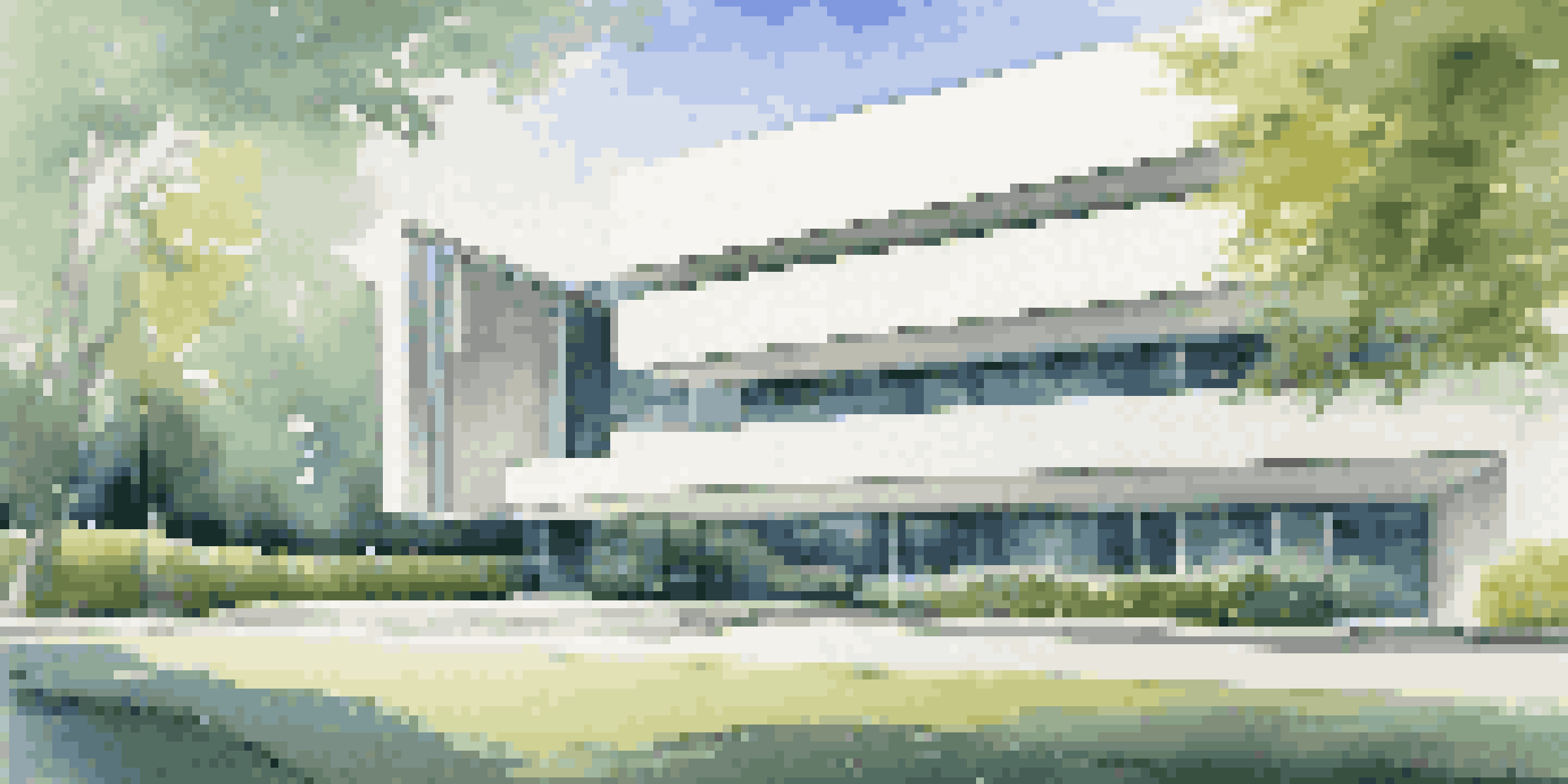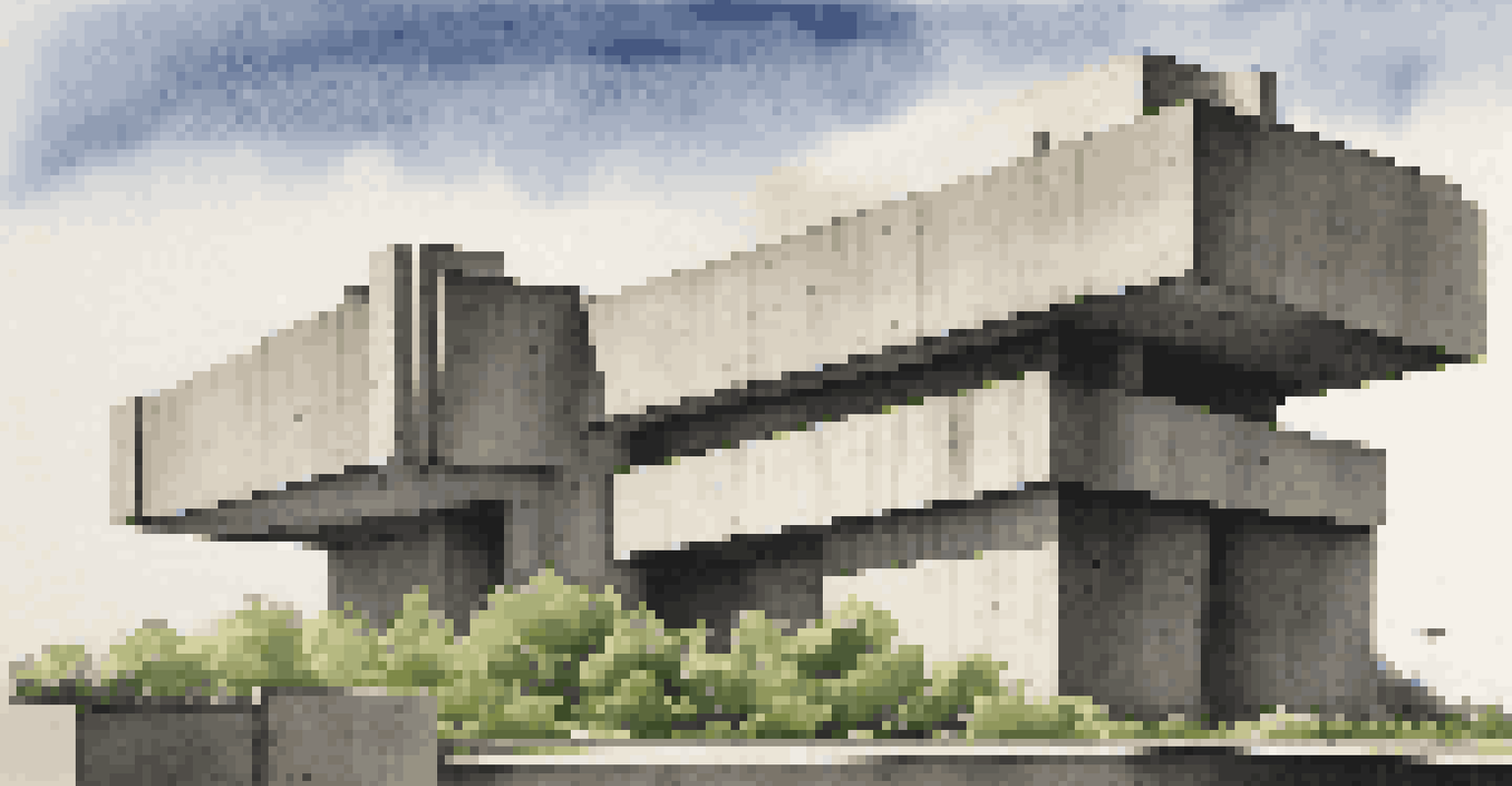Artistic Expression in Modernist Architectural Movements

Understanding Modernism: A Brief Overview
Modernism emerged in the late 19th and early 20th centuries as a response to traditional architectural styles. It sought to break away from historical precedents and embrace innovation, simplicity, and functionality. This movement was not just about aesthetics; it was about reflecting the rapidly changing society of the time. Architects aimed to express ideas about modern life through their designs, making architecture a canvas for artistic exploration.
Less is more.
The rise of industrialization influenced this shift, leading to new materials and construction techniques. Steel and concrete became favored choices, enabling architects to create bold structures that challenged conventional forms. Modernist architecture was about more than just buildings; it was a reflection of contemporary culture, technology, and philosophy, paving the way for future architectural movements.
As we delve deeper into modernist movements, we can see how artistic expression played a crucial role in shaping their identity. From the clean lines of Bauhaus to the organic forms of Frank Lloyd Wright, each style offers a unique perspective on how art and architecture intertwine.
Bauhaus: Where Art Meets Functionality
Founded in 1919, the Bauhaus school revolutionized the relationship between art and design. Its influence extended beyond architecture, impacting furniture design, typography, and even textiles. The core philosophy was that form should follow function, leading to designs that were both aesthetically pleasing and practical. This approach blurred the lines between art and everyday life, making artistic expression accessible to all.

The Bauhaus movement embraced simplicity and minimalism, stripping away unnecessary ornamentation. This focus on essential forms allowed for a new kind of beauty that resonated with the modern spirit. The use of geometric shapes and a limited color palette became hallmarks of Bauhaus designs, creating a visual language that spoke to the values of the time.
Modernism Redefines Architectural Art
Modernism emerged as a response to traditional styles, emphasizing innovation and reflecting the societal changes of its time.
Architects like Walter Gropius and Mies van der Rohe exemplified these principles in their work. They transformed spaces into functional, yet artistic environments, proving that buildings could be both useful and inspiring. The legacy of Bauhaus continues to influence contemporary design, reminding us of the power of artistic expression in architecture.
Art Deco: A Celebration of Elegance
Emerging in the 1920s, Art Deco was a vibrant architectural style that celebrated luxury and glamour. Characterized by bold colors, geometric shapes, and lavish details, it was a departure from the stark minimalism of earlier modernist movements. Art Deco buildings often featured intricate decorations, reflecting the exuberance of the Roaring Twenties and the optimism of the post-World War I era.
The best way to predict the future is to create it.
This style drew inspiration from various sources, including ancient cultures, nature, and technological advancements. The integration of artistic elements such as murals and sculptures into buildings created a narrative that engaged viewers and enhanced their experience. Art Deco was not just about aesthetics; it was a cultural statement that embodied the spirit of its time.
Notable examples of Art Deco architecture include the iconic Chrysler Building in New York City and the Palais de Chaillot in Paris. These structures showcase how artistic expression can transform functional spaces into landmarks that capture the imagination. Through Art Deco, we see how architecture can serve as a canvas for cultural storytelling.
Brutalism: Raw Beauty in Architecture
Brutalism emerged in the mid-20th century as a bold architectural style that emphasized raw materials and structural honesty. Characterized by massive concrete forms and a lack of ornamentation, Brutalist buildings often evoke a sense of strength and permanence. This style was a reaction against the decorative elements of previous movements, favoring a more utilitarian approach to design.
Despite its often controversial appearance, Brutalism was grounded in a deep artistic philosophy. Architects like Le Corbusier and Louis Kahn utilized concrete not just for its structural properties, but as a medium for artistic expression. The rough textures and monumental forms of Brutalist structures invite viewers to appreciate the beauty found in simplicity and solidity.
Sustainability Shapes Architecture Today
The focus on sustainability in architecture merges aesthetic beauty with ecological responsibility, inspiring innovative designs.
Brutalism has faced criticism over the years, yet it continues to inspire architects and artists alike. Its legacy is evident in many public buildings and cultural institutions, where the interplay of light and shadow creates a dynamic visual experience. Ultimately, Brutalism challenges us to rethink our perceptions of beauty in architecture.
Deconstructivism: Embracing Fragmentation
Deconstructivism emerged in the late 20th century as a radical architectural movement that challenged traditional notions of form and structure. It embraced chaos and fragmentation, resulting in designs that appear disordered yet intentional. This style often features non-linear shapes and unexpected angles, creating a sense of dynamism and movement in architectural spaces.
Architects like Frank Gehry and Zaha Hadid pushed the boundaries of conventional design, using advanced technology and materials to realize their visions. Deconstructivism reflects a postmodern sensibility, questioning established norms and inviting viewers to engage with architecture in new ways. The artistic expression inherent in this movement often elicits strong emotional responses, making each building a unique experience.
Despite its complexity, deconstructivism has made a significant impact on contemporary architecture. Its emphasis on artistic freedom and innovation encourages architects to explore unconventional ideas. By breaking away from traditional constraints, deconstructivism opens the door to new possibilities in architectural design.
Sustainability: The Art of Responsible Design
In recent years, the architectural landscape has begun to embrace sustainability as a critical component of artistic expression. Modern architects are increasingly aware of their environmental impact and are seeking innovative solutions to create eco-friendly structures. This shift reflects a growing understanding that architecture can be both beautiful and responsible, merging aesthetics with ecological awareness.
Sustainable design often incorporates natural elements and eco-friendly materials, resulting in buildings that harmonize with their surroundings. Architects utilize techniques like passive solar design and green roofs to minimize energy consumption while enhancing the visual appeal of their structures. This approach not only benefits the planet but also creates a sense of well-being for occupants.
Future of Architecture Embraces Tech
Advancements in technology are allowing architects to explore new forms and materials, enriching the artistic expression in architecture.
As sustainability becomes a central theme in architecture, artists and architects alike are finding new ways to express their commitment to the environment. This merging of artistic vision and ecological responsibility is leading to innovative designs that inspire future generations. Ultimately, the art of responsible design illustrates that modern architecture can be a powerful tool for positive change.
The Future of Artistic Expression in Architecture
As we look to the future, the role of artistic expression in architecture continues to evolve. The integration of technology, such as 3D printing and virtual reality, is enabling architects to experiment with new forms and materials. This technological revolution offers exciting possibilities for creative expression, allowing for designs that were once unimaginable.
Moreover, the dialogue between architecture and other artistic disciplines is becoming increasingly prominent. Collaborations between architects, artists, and designers are leading to innovative projects that blur the lines between art and architecture. This interdisciplinary approach fosters a richer understanding of how spaces can evoke emotions and enhance the human experience.

In conclusion, the future of artistic expression in architecture promises to be dynamic and inspiring. By embracing new technologies and fostering collaboration, architects can continue to create spaces that resonate with people on a profound level. As we move forward, the interplay between art and architecture will remain a vital aspect of our built environment.